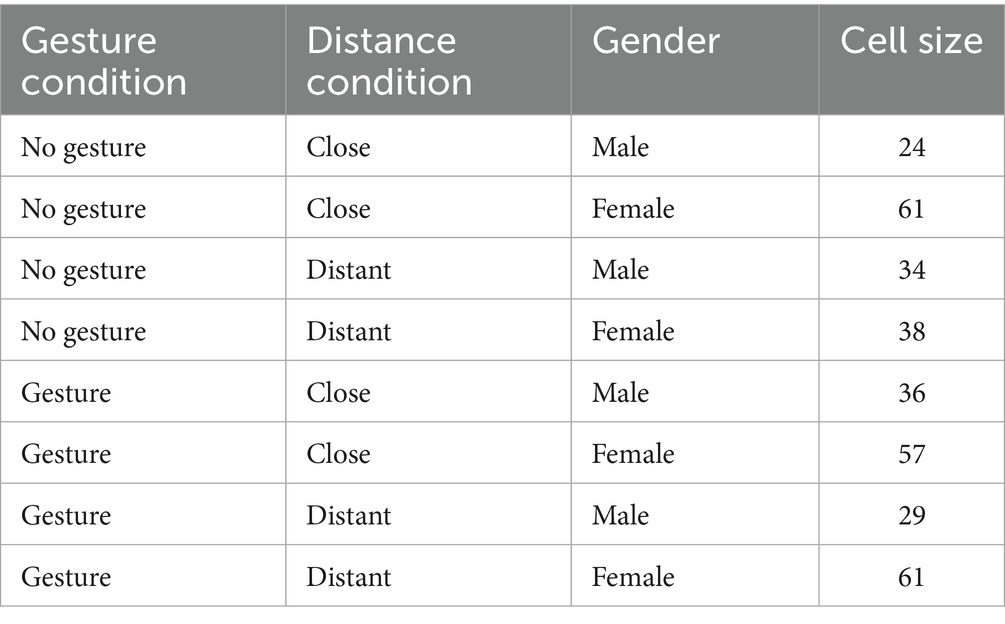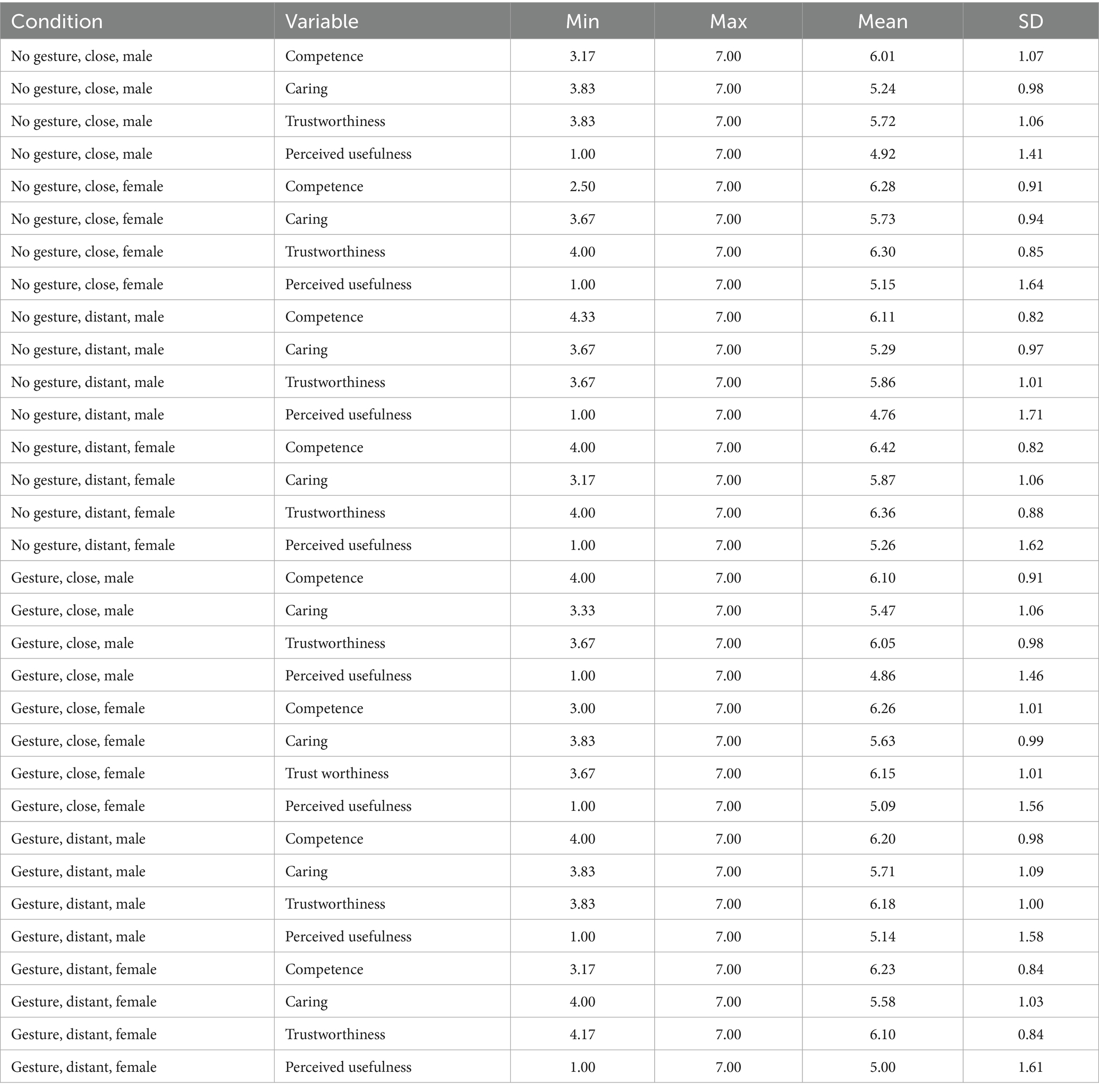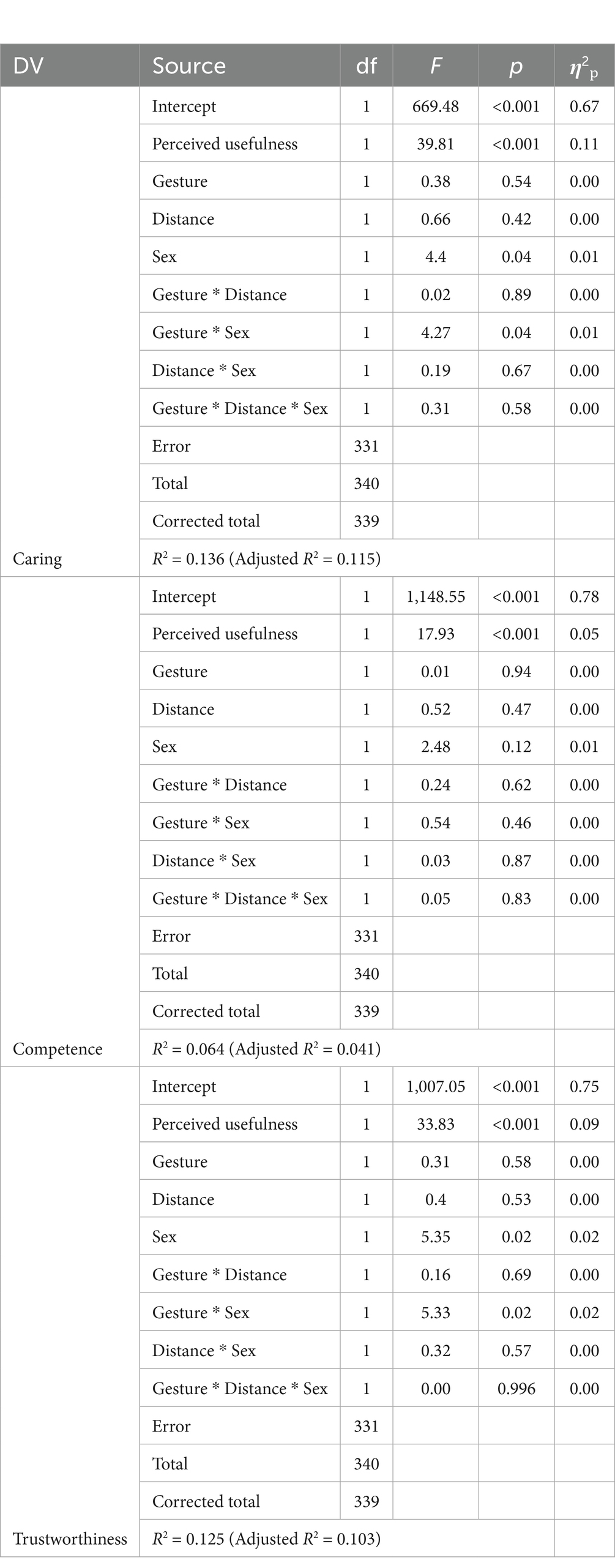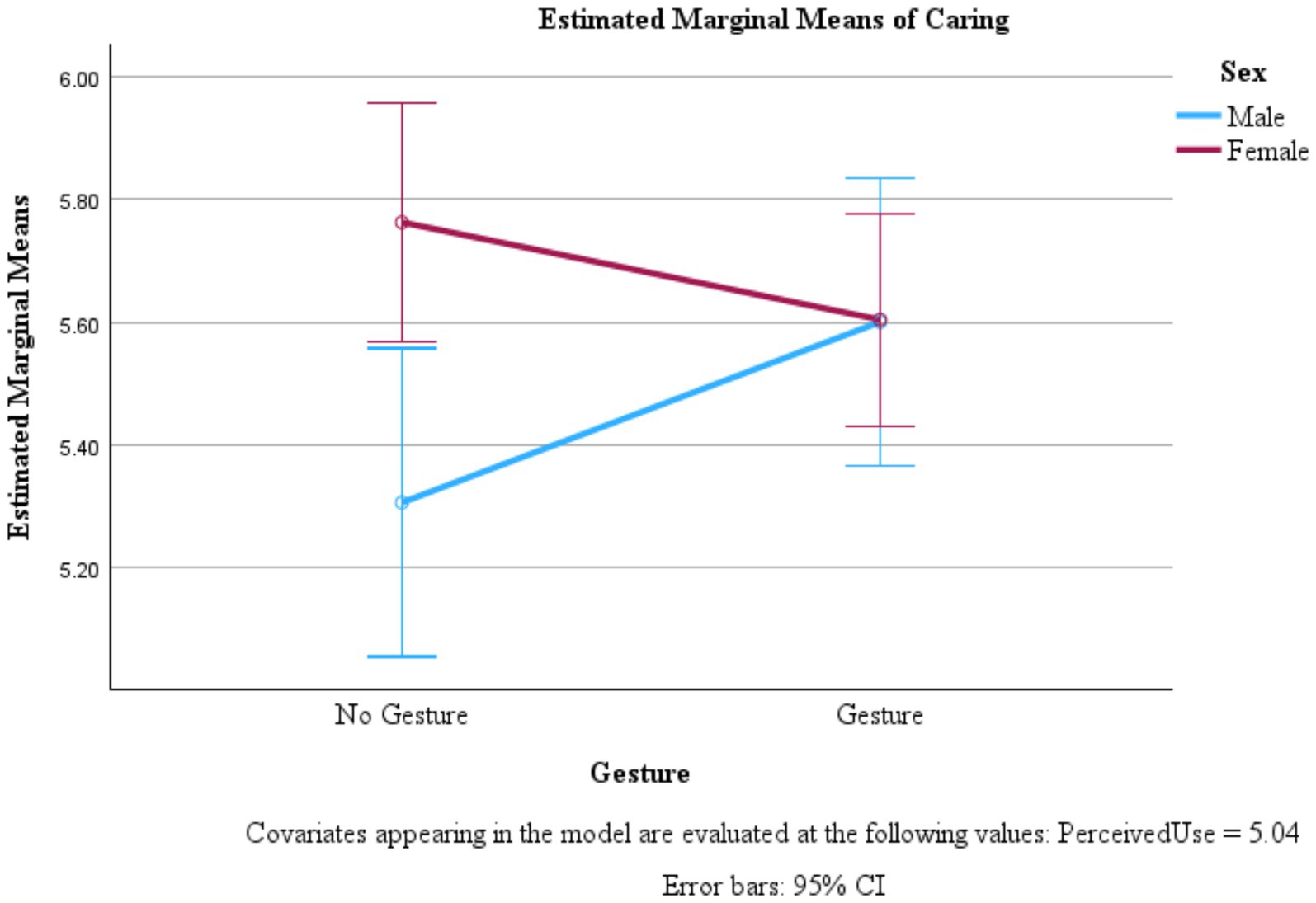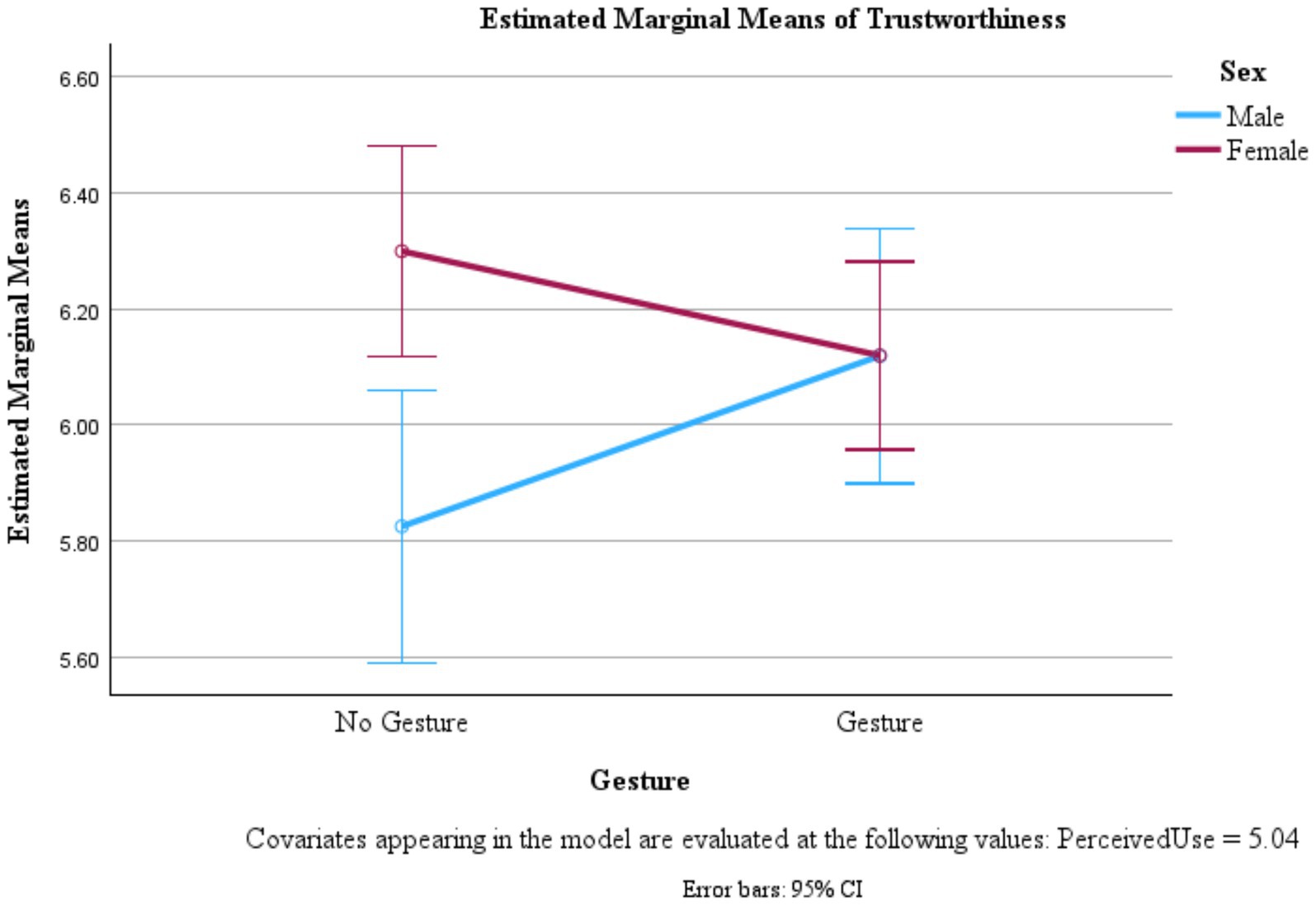- 1Department of Business Information Systems and Analytics, North Carolina A&T State University, Greensboro, NC, United States
- 2Nicholson School of Communication and Media, University of Central Florida, Orlando, FL, United States
The purpose of this study was to establish the importance of instructor gestures in online lectures. Social information processing theory explains that virtual communication can be just as effective as face-to-face communication if communicators understand how to adapt their communication to the virtual channel. This study seeks to better understand the roles of camera distance and gestures in adapting lectures to virtual classrooms. An experiment examined the impact of student gender, camera distance from the instructor, and gesture use on instructor credibility, as measured by caring, competence, and trustworthiness. The results indicate that while camera distance did not impact students’ perceptions of instructor competence, the absence of gestures did impact how trustworthy and caring male students perceived the instructor to be. In the absence of gestures, male students perceived the instructor to be less caring and trustworthy. This indicates that instructors should make efforts to speak with gestures in virtual lectures, especially for male students, just as they do in the traditional classroom.
1 Introduction
Instructors’ use of gestures while teaching has long been established as a tool for enhancing credibility in face-to-face classrooms (Miller et al., 2014; Witt et al., 2014) and can improve students’ attention and academic performance (Kushch et al., 2018; Macedonia et al., 2011). However, whether these benefits extend to virtual learning environments is unclear. Social information processing theory (SIPT) suggests virtual communication can be just as effective as face-to-face interaction when communicators adapt their behaviors to fit the channel’s strengths and constraints (Walther, 1992). As such, there is a need to understand how an instructor’s adapted communication behavior (e.g., using gesture or not) in a virtual channel affects students’ perceptions of their instructor.
Instructor credibility is a good indicator of how students perceive an instructor. It has emerged as a super-variable that affects teacher-student interactions and instructional outcomes (Teven and Katt, 2016), Credibility is a multidimensional construct consisting of caring, competence, and trustworthiness (McCroskey and Teven, 1999; Myers and Martin, 2017; Teven and Katt, 2016). Caring is the extent to which a message receiver perceives the communicator has goodwill intentions through the information they are sharing. Competence refers to the degree to which the communicator appears to know what they are doing. Trustworthiness is the extent to which the communicator is perceived to be speaking the truth. Together, these three variables assess the overall believability of a communicator (McCroskey and Teven, 1999; Teven and Katt, 2016), and students evaluate instructors’ credibility based on how instructors use technology (Myers and Martin, 2017).
Some research has examined how to adapt instructor lecture behaviors to the online environment. The extant literature documents that enhanced instructor expressiveness in video lectures improved student psychological arousal and learning satisfaction (Wang et al., 2019). Seeing the instructor on screen increased perceived credibility (Ramlatchan and Watson, 2020) and social presence (Heidig et al., 2024) compared to slides alone (Ramlatchan and Watson, 2020), consistent with SIPT’s emphasis on visible social cues.
However, there is limited empirical research on nonverbal behaviors, specifically, how to fine-tune instructors’ gestures on the screen to best fit the virtual channel. To address this research gap, the present research is proposed. In particular, the study examines how instructor gestures in video lectures influence instructor credibility, an important construct affecting student learning experiences.
Based on the guidance of SIPT, if gestures are visible and interpretable in the video channel, they should enhance the communication experience since those cues are adapted to the channel. Our first hypothesis is that visible instructor gestures in a video lecture will increase perceived credibility [(a) caring, (b) competence, (c) trustworthiness] compared with no gestures.
A limitation of online lecture communication is camera framing, which determines the space available to display gestures. In the physical classroom, instructors’ whole bodies are visible, but they can move out of frame in virtual lectures. Hathaway (2020) suggests the most natural-looking distance from the webcam is one in which the camera captures a headshot space (i.e., only head and shoulders). Although this may be the most natural framing for a virtual meeting, it is a much closer view of an instructor than students would have in a physical classroom, and it limits the range of motion available for instructors to make gestures. According to SIPT (Walther, 1992), effective virtual communication occurs when communicators adapt their behaviors to match the capabilities and constraints of the medium. This suggests that adjusting the visual framing to allow for natural gestures may enhance students’ perception of instructor presence and relational cues. Our second hypothesis is that a wider camera framing that creates more space for gestures will increase perceived credibility [(a) caring, (b) competence, (c) trustworthiness] relative to head-and-shoulders framing.
Student gender may also influence how instructor gestures are perceived during virtual lectures. Prior work shows gender differences in how students adopt and attend to instructional media (Park et al., 2019; Zhang and Yang, 2022), including evaluation of instructor video settings (Kelly et al., 2024a; Kelly et al., 2024b). Female students tend to evaluate instructor credibility consistently across different uses of instructional technology, whereas male students evaluate credibility more critically depending on the instructor’s technology choices (Kelly et al., 2024b; Schrodt and Witt, 2006). Given the extant literature on how student gender moderates how students perceive instructors’ uses of learning technologies, our third hypothesis is that student sex will moderate the effects of instructor gestures and camera framing on perceived credibility [(a) caring, (b) competence, and (c) trustworthiness] such that more credibility is perceived by female students.
2 Method
The following section explains the experimental design and instruments used for measurement. IRB approval was granted before data collection began.
2.1 Materials
To develop the materials for this experiment, an instructor (White, female, 40 years old) was given a script on one-way interviews to practice until she could exactly replicate her delivery in terms of timing, gestures, and vocal inflection. The instructor was aided by the researchers in developing gestures for the videos to ensure the gestures looked natural, but her hands remained at shoulder height or higher. Once the lecture could be replicated exactly, it was recorded twice with a high-definition camera zoomed out enough that the instructor was captured from the hips up. The video was recorded twice in front of a solid background: once with the practiced gestures and once with the instructor’s hands clasped in front of her. All aspects of the video were identical except for gestures. The total time for both videos was 2 min and 10 s.
Once the videos were completed, both videos were copied and cropped at the same aspect ratio to show the instructor from the shoulder up, as one would expect to see an instructor speaking into a webcam during a video conference. This provided four videos:
1. Close (a head-and-shoulders framing) with gestures
2. Close (a head-and-shoulders framing) without gestures
3. Distant (waist-up framing) with gestures
4. Distant (waist-up framing) without gestures
The university online learning emblem was imposed into the upper left-hand corner of the screen to reinforce the authenticity of each video condition.
2.2 Procedure
Undergraduate students were recruited to participate in the study for extra credit in multiple mass lecture courses via email. They were provided with a URL that directed their browser to an informed consent. Once they acknowledged their consent, they were able to proceed to a video embedded in the questionnaire. This experiment used a quasi-experimental 2 × 2 × 2 (distant vs. close × gestures vs. no gestures × male vs. female) factorial design with participants being assigned at random to see one of the four videos and then assessing the instructor’s credibility. Between the video and assessments, participants were asked to complete two attention checks. The research questions were addressed with a series of ANCOVAs using student gender, the distance condition, and the gesture condition as independent variables; perceived usefulness as a covariate; and each of the credibility variables as dependent variables. The questionnaire was encoded so participants could not proceed to the full study until the video finished playing. In total, participation required approximately 6 min to complete the study.
2.3 Participants
Initially, 409 students responded to this study. To ensure the quality of the data, a series of data cleaning processes were performed. First, 26 individuals indicated they had completed the study more than once. Second, 11 individuals reported they had seen the instructor before, due to a previous research study that employed the same instructor in the stimuli. Third, one individual failed a general attention check related to study participation. Fourth, one individual failed a specific attention check that asked about the instructor’s sex. Fifth, 22 individuals failed another specific attention check that asked about the lecture content they listened to. Finally, data were reviewed for patterned or straight answers, and seven participants were identified as problematic. All of these unreliable responses were removed from the dataset.
The final sample size was 341 participants. The average age of participants was 22.2 years (SD = 4.82). The gender distribution included 123 individuals identifying as male, 217 as female, and one participant who did not specify a gender identity. For academic standing, the sample consisted of 12 first-year students, 58 sophomores, 160 juniors, and 106 seniors, while five participants did not report their class rank. Regarding ethnicity, 169 participants identified as White, 90 as Hispanic/Latinx, 47 as Black, 18 as Asian, 16 reported multiple ethnic backgrounds, and one participant did not specify an ethnicity. Table 1 shows the number of participants per experimental condition. Imbalance was caused primarily by data cleaning and secondarily by the random assignment algorithm not considering student sex when assigning video conditions.
2.4 Instrumentation
Credibility was measured with McCroskey and Teven’s (1999) multi-dimensional assessment. The measure is composed of 18 semantic differential items with a seven-point response range, with six items dedicated to measuring caring, competence, and trustworthiness, respectively. Factor structures of measures were examined through confirmatory factor analysis. All measures showed acceptable fit: caring Goodness of Fit Index (GFI) = 0.92, Comparative Fit Index (CFI) = 0.91, Root Mean Square Error Approximation (RMSEA) = 0.16, and Standard Root Mean Residual (SRMR) = 0.06, competence GFI = 0.99, CFI = 1.00, RMSEA = 0.02, and SRMR = 0.02, and trustworthiness GFI = 0.95, CFI = 0.97, RMSEA = 0.12, and SRMR = 0.03. Reliability scores were as follows: caring ω = 0.84, competence ω = 0.89, and trustworthiness ω = 0.90.
Additionally, participants were asked to rate with a single seven-point item on how useful they perceived the lecture content to be. This assessment was included to help control for participants who may have paid more attention to the lecture or instructor because they are preparing for an interview compared to students who did not perceive the content to be relevant. Table 2 shows the descriptive statistics for all measures.
3 Results
All hypotheses were analyzed with ANCOVAs with perceived usefulness of the lecture material added as a covariate. Assumptions of normality of residuals, homogeneity of variance, and homogeneity of regression slopes were checked, and no violations were detected. All main and interaction effects are summarized in Table 3.
For caring, Levene’s test of homogeneity of error variances suggested equal variance across cells [F(7, 332) = 0.39, p = 0.91]. Perceived usefulness was a statistically significant covariate. The main effects of gesture and distance were not significant, inconsistent with expectations. However, the effect of sex was significant such that females rated instructors as more caring than males, consistent with predictions. Notably, this sex difference was more pronounced in the no gesture condition (see Figure 1).
For competence, Levene’s test suggested equal variance across cells [F(7, 332) = 0.65, p = 0.72]. Perceived usefulness, a covariate, again predicted the credibility dimension of competence. Neither main nor interaction effects were significant, not supporting hypothesized predictions.
For trustworthiness, Levene’s test suggested equal variance across cells [F(7, 332) = 1.16, p = 0.18]. Perceived usefulness was again a significant covariate. There were no main effects of gesture and distance, inconsistent with predictions. However, there was a sex difference, such that females rated instructors to be more trustworthy than males, consistent with expectations. Notably, an interaction effect with gesture and sex indicated that this difference was most pronounced in the no gesture condition (see Figure 2 for a visual depiction of this interaction effect).
4 Discussion
This study revealed several notable findings. First, there are sex differences such that female students perceived the instructor as more caring and trustworthy, regardless of how they adapted their communication to the technology, as hypothesized in relation to caring and trustworthiness. In fact, this pattern is consistent with the findings of Kelly et al. (2024b), indicating that this consistency across studies suggests a broader trend rather than a sample-specific anomaly (McEwan et al., 2018). Although the persistence of sex differences raises questions about whether these perceptions reflect enduring gender norms in instructional evaluation rather than instructional behavior per se, this consistent pattern is important to keep in mind.
Another significant finding of this study is the effect of perceived usefulness, a covariate used in all hypotheses, on instructor credibility. Instructors were simply perceived to be more credible (caring, competence, and trustworthiness) when students perceived the lecture content was something they could apply to their lives. This extends past work on relevance in classroom disclosure (Myers et al., 2009; Schrodt, 2013) by showing that even in virtual lectures, content relevance may override nonverbal delivery cues such as gesture or distance. As such, relevance of what is shared is reinforced as an important predictor of how students evaluate instructor credibility.
Partially consistent with the expectation about camera distance, the study also found that gesture use moderated credibility perceptions for male students, particularly for caring and trustworthiness. This suggests that in order to establish perceptions of caring and trustworthiness among male students during virtual lectures, it is important for instructors to use gestures while speaking. For example, if an instructor sits still with their hands rested on the desk during a virtual lecture, male students are less likely to perceive them as caring or trustworthy than if they use hand gestures while speaking. This finding suggests that instructors should incorporate visible gesturing to foster credibility among male students, though the absence of a similar effect for females indicates that gestures do not universally enhance instructor credibility. Beyond student perceptions, gesturing during lecture recording may also benefit instructors themselves; Yang et al. (2020) found that instructors reported lower stress while recording lectures if they gestured while speaking. Thus, gestures may be beneficial to not only male students but also instructors themselves.
Contrary to the expectation about camera framing, camera distance did not influence credibility. Also, the absence of gestures affected only male students, which was inconsistent with the prediction regarding gestures. This null effect raises questions about SIPT’s prediction that greater nonverbal bandwidth should enhance cue effectiveness; it may be that once gestures are visible, frame size adds little benefit. According to SIPT, adapting nonverbal cues to the communication channel enhances their effectiveness. In this study, the instructor’s gestures were clearly visible and tailored to the camera frame, aligning with this principle. If the gestures were not adapted well to the camera frame, perceptions of gestures may not have been as well received by male students. Thus, the findings support that gestures contribute to perceptions of trustworthiness and caring among male students when adapted to be visible within the camera frame during virtual lectures.
Surprisingly, the study found that instructor competence was not impacted by gesture use, camera distance, or student sex, as shown in the results concerning competence, caring, and trustworthiness. Indeed, the instructor was perceived to be equally competent across all conditions. This aligns with prior research findings (e.g., Myers and Martin, 2017; Teven and Katt, 2016), suggesting that competence judgments may rely more on enduring impressions of expertise than situational delivery cues. Thus, unlike caring or trustworthiness, competence may be relatively impervious to short-term exposure to nonverbal behavior in virtual lectures. Assessments of competence reflect the instructor’s skills while assessments of caring and trustworthiness are social dispositions. As such, male students’ assessments of instructor credibility are only affected by the presence of gesturing, as gestures influence their perceptions of the instructor toward them. In short, for male students, gestures appear to influence dimensions of credibility, specifically caring and trustworthiness, because they signal the instructor’s effort and intentionality in supporting student learning.
4.1 Limitations
This study was limited by its manipulations. First, while distance was manipulated in this study, only two conditions were considered: head and shoulders vs. hips up. Neither of these conditions reflect the face-to-face classroom view where students would see the instructor’s entire body. Secondly, the gestures utilized for this study were limited to beats (i.e., emphatic gestures) that complemented spoken words and stayed within the frame. Therefore, this study cannot account for the role of gestures if the instructor has something to gesture at nor whether the gestures are perceived differently if they extend outside of the camera frame. Future research is needed to consider these additional conditions.
4.2 Conclusion
The study reveals an important takeaway message that instructor gestures matter for male students when delivering virtual lectures. In the absence of gestures, male students perceived the instructor to be less trustworthy and less caring, and as such overall less credible, implying that a best practice for instructors is to use their hands to emphasize the lecture content as they would in the face-to-face classroom. This may mean instructors speaking in a standard video conferencing configuration may need to scoot away from their desk while speaking so that they are not tempted to rest their hands on the desk rather than using them to enhance content delivery. Overall, this study confirmed that as is true for the face-to-face classroom, the use of gestures while lecturing is also important for establishing credibility as an instructor in the virtual classroom. Future research should explore how gestures function when the instructor gestures at classroom objects, or when gestures extend outside the camera frame. These findings also suggest that instructors and instructional designers should intentionally incorporate visible, purposeful gesturing into virtual lecture delivery to support credibility, especially among male students.
Data availability statement
The datasets presented in this article are not readily available because the data can be accessed by contacting the first author with a reasonable request per IRB guidelines. Requests to access the datasets should be directed to c2VrZWxseUBuY2F0LmVkdQ==.
Ethics statement
The studies involving humans were approved by University of Central Florida IRB Board. The studies were conducted in accordance with the local legislation and institutional requirements. The participants provided their written informed consent to participate in this study.
Author contributions
SK: Writing – review & editing, Formal analysis, Writing – original draft, Methodology, Conceptualization. JK: Resources, Data curation, Conceptualization, Formal analysis, Methodology, Writing – review & editing, Writing – original draft. PC: Writing – original draft, Writing – review & editing.
Funding
The author(s) declare that no financial support was received for the research and/or publication of this article.
Conflict of interest
The authors declare that the research was conducted in the absence of any commercial or financial relationships that could be construed as a potential conflict of interest.
Generative AI statement
The authors declare that no Gen AI was used in the creation of this manuscript.
Any alternative text (alt text) provided alongside figures in this article has been generated by Frontiers with the support of artificial intelligence and reasonable efforts have been made to ensure accuracy, including review by the authors wherever possible. If you identify any issues, please contact us.
Publisher’s note
All claims expressed in this article are solely those of the authors and do not necessarily represent those of their affiliated organizations, or those of the publisher, the editors and the reviewers. Any product that may be evaluated in this article, or claim that may be made by its manufacturer, is not guaranteed or endorsed by the publisher.
References
Hathaway, J. L. (2020). Zoom video conferencing: putting your best foot forward. Mich. Bar J. 99, 54–55.
Heidig, S., Beege, M., Rey, G. D., and Schneider, S. (2024). Instructor presence in instructional videos in higher education: three field experiments in university courses. Educ. Technol. Res. Dev. 72, 3047–3074. doi: 10.1007/s11423-024-10391-9
Kelly, S., Kim, J., Berry, I., and Goke, R. (2024a). Student impressions of instructors based on zoom backgrounds: investigating perceived technology skills of instructors and affective learning of students. Front. Comput. Sci. 6:1392669. doi: 10.3389/fcomp.2024.1392669
Kelly, S., Kim, J., Goke, R., and Bryant, K. (2024b). Do instructors’ choice of virtual background in online classes matter? Effects of personal vs. professional virtual background use on instructor credibility and student learning. Int. J. Hum. Comput. Interact. 40, 7314–7321. doi: 10.1080/10447318.2023.2263695
Kushch, O., Igualada, A., and Prieto, P. (2018). Prominence in speech and gesture favour second language novel word learning. Lang. Cogn. Neurosci. 33, 1–13. doi: 10.1080/23273798.2018.1435894
Macedonia, M., Müller, K., and Friederici, A. D. (2011). The impact of iconic gestures on foreign language word learning and its neural substrate. Hum. Brain Mapp. 32, 982–998. doi: 10.1002/hbm.21084
McCroskey, J. C., and Teven, J. J. (1999). Goodwill: a re-examination of the construct and its measurement. Commun. Monogr. 66, 90–103. doi: 10.1080/03637759909376464
McEwan, B., Carpenter, C. J., and Westerman, D. (2018). On replication in communication science. Commun. Stud. 69, 235–241. doi: 10.1080/10510974.2018.1464938
Miller, A. N., Katt, J. A., Brown, T., and Sivo, S. A. (2014). The relationship of instructor self-disclosure, nonverbal immediacy, and credibility to student incivility in the college classroom. Commun. Educ. 63, 1–16. doi: 10.1080/03634523.2013.835054
Myers, S. A., and Brann, M.Members of Comm 600 (2009). College students' perceptions of how instructors establish and enhance credibility through self-disclosure. Qual. Res. Rep. Commun. 10, 9–16. doi: 10.1080/17459430902751808
Myers, S. A., and Martin, M. M. (2017). “Instructor credibility” in Handbook of instructional communication. eds. M. L. Houser and A. Hosek (Abingdon: Routledge), 38–50.
Park, C., Kim, D. G., Cho, S., and Han, H. J. (2019). Adoption of multimedia technology for learning and gender difference. Comput. Hum. Behav. 92, 288–296. doi: 10.1016/j.chb.2018.11.029
Ramlatchan, M., and Watson, G. S. (2020). Enhancing instructor credibility and immediacy in online multimedia designs. Educ. Technol. Res. Dev. 68, 511–528. doi: 10.1007/s11423-019-09714-y
Schrodt, P. (2013). Content relevance and students' comfort with disclosure as moderators of instructor disclosures and credibility in the college classroom. Commun. Educ. 62, 352–375. doi: 10.1080/03634523.2013.807348
Schrodt, P., and Witt, P. L. (2006). Students’ attributions of instructor credibility as a function of students’ expectations of instructional technology use and nonverbal immediacy. Commun. Educ. 55, 1–20. doi: 10.1080/03634520500343335
Teven, J., and Katt, J. (2016). “Instructor credibility” in Handbook of communication science: communication and learning. ed. P. L. Witt (Berlin: De Gruyter Mouton), 183–210.
Walther, J. B. (1992). Interpersonal effects in computer-mediated interaction: a relational perspective. Commun. Res. 19, 52–90. doi: 10.1177/009365092019001003
Wang, Y., Liu, Q., Chen, W., Wang, Q., and Stein, D. (2019). Effects of instructor's facial expressions on students' learning with video lectures. Br. J. Educ. Technol. 50, 1381–1395. doi: 10.1111/bjet.12633
Witt, P. L., Schrodt, P., Wheeless, V. E., and Bryand, M. C. (2014). Students' intent to persist in college: moderating the negative effects of receiver apprehension with instructor credibility and nonverbal immediacy. Commun. Stud. 65, 330–352. doi: 10.1080/10510974.2013.811428
Yang, J., Zhu, F., Guo, P., and Pi, Z. (2020). Instructors' gestures enhance their teaching experience and performance while recording video lectures. J. Comput. Assist. Learn. 36, 189–198. doi: 10.1111/jcal.12397
Keywords: credibility, competence, trustworthiness, caring, virtual lectures, gestures
Citation: Kelly S, Kim J and Chaudhary P (2025) Understanding the role of instructor gestures during virtual lectures. Front. Comput. Sci. 7:1615791. doi: 10.3389/fcomp.2025.1615791
Edited by:
Octavian Dospinescu, Alexandru Ioan Cuza University, RomaniaReviewed by:
Noor Akmal Shareela Ismail, National University of Malaysia, MalaysiaMaik Beege, University of Education Freiburg, Germany
Copyright © 2025 Kelly, Kim and Chaudhary. This is an open-access article distributed under the terms of the Creative Commons Attribution License (CC BY). The use, distribution or reproduction in other forums is permitted, provided the original author(s) and the copyright owner(s) are credited and that the original publication in this journal is cited, in accordance with accepted academic practice. No use, distribution or reproduction is permitted which does not comply with these terms.
*Correspondence: Stephanie Kelly, c2VrZWxseUBuY2F0LmVkdQ==
 Stephanie Kelly
Stephanie Kelly Jihyun Kim
Jihyun Kim Pankaj Chaudhary
Pankaj Chaudhary